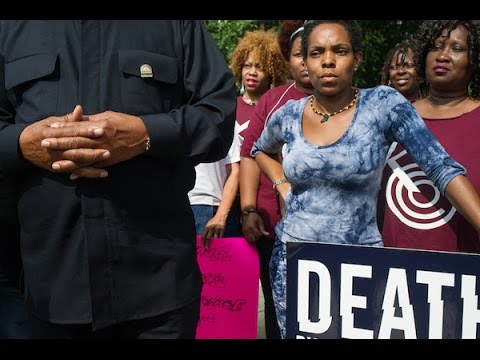
When school starts next week, Dyett High School will reopen its doors and welcome some 150 freshmen. Inside, a memorial will eventually pay tribute to the school’s history, including the dozen hunger strikers who made international news with their protest to keep the school from shutting down.
Jitu Brown, a veteran community activist and an organizer of the strike, says it’s important that the students understand what it took to reach this point. “This school was born out of struggle,” he said.
The roots of the hunger strike were laid in 2012, when the school board voted to phase out Dyett. At the time, dozens of other schools in black communities across the city were being shut down; Brown and other leaders were already angered at the situation in Bronzeville, which had been hit by nearly a dozen closures and consolidations.
Shutting down Dyett, they said, would leave young people in the community without any neighborhood high school, with the closest one two miles away. Rallies and sit-ins ensued, eventually forcing the district to promise to keep Dyett open.
A coalition of community members and organizers envisioned Dyett with a new, revamped curriculum focused on green technology and global leadership. But when Chicago Public Schools delayed a final vote on a plan, activists turned to the hunger strike as a last resort. They sat in Washington Park—where Dyett is located—in the summer heat, drinking only liquids for 34 days.
National and international media covered the story. Mass protests were held inside City Hall. After one hunger striker fainted at a school board meeting, two board members pressed the district to make a final decision on Dyett. Newly appointed CEO Forrest Claypool and Chief Education Officer Janice Jackson announced that Dyett would reopen this fall—but as an arts school, not the green tech school that the strikers wanted.
A year later, Brown says getting that news was “extremely frustrating.” But in the end, the strike achieved its main goals: Dyett remains open, with seats set aside solely for neighborhood students and with some green technology curriculum included.
The school also keeps its name as a testament to Walter H. Dyett, a legendary African-American music teacher who taught students like Nat King Cole and Dinah Washington.
“That’s a big milestone. That’s a good victory,” says Anna Jones, one of the hunger strikers. “Because before we stopped eating, it was as good as closed. So we were able to save something.”
“We’re part of the process, not as much as we would like to be, but we do have a say-so on some of the things going on,” says Jeanette Taylor, another hunger strike participant.
The hunger strikers believe their protest had a lasting impact on the city by drawing attention to racial disparities in resources within Chicago Public Schools.
“I was a mother who felt like she didn’t have a voice, [but] there are plenty of other parents around this city who felt the exact same way,” Taylor says. “We inspired and woke the sleeping giant, because now you hear people saying ‘These are the inequities in my school. What is the school district going to do about it?’”
During a tour of the renovations at Dyett, which now has a black-box theater, a dance room and a student art gallery, Jackson said that the improvements show that “compromise was possible.” She saw Dyett and other recent decisions, such as cancelling a proposed co-location in Little Village after parents protested, as evidence that the district is “listening more to the community.”
The hunger strikers and members of the coalition that pushed to reopen Dyett are working to make sure the school continues to recruit students from the neighborhood and eventually elects a local school council to make budgeting and other decisions.
Jones said she wants the young people at Dyett to have the same opportunities as students in wealthier schools on the city’s North Side, “so that they can have an even playing field to compete in this world — because without that, they will not.”



The Dyett hunger strikers gave the lie to the entire sales pitch of “school choice” by demonstrating quite clearly that “choice” is a lie since parents never have had nor are ever permitted to have a seat at the table where what will be made available to choose from is decided upon. As was shown by the mayors and CPS’s reactions to the hunger strikers, parents and community members who dare to raise their voices to make their actual choice known are ridiculed, marginalized and denied. This is true all over America, and the Dyett hunger strikers proved that the mayor and CPS are solidly on the side of those who do not care about the actual choices that parents want to make on behalf of their kids. Their plan for Dyett was world class, a school that any community would be very happy with, but Rahm and Claypool didn’t dare establish a precedent for real choice by implementing that world class plan. Those control freaks had to prevent that at all costs on behalf of the false choice pushers that they get their marching orders from.